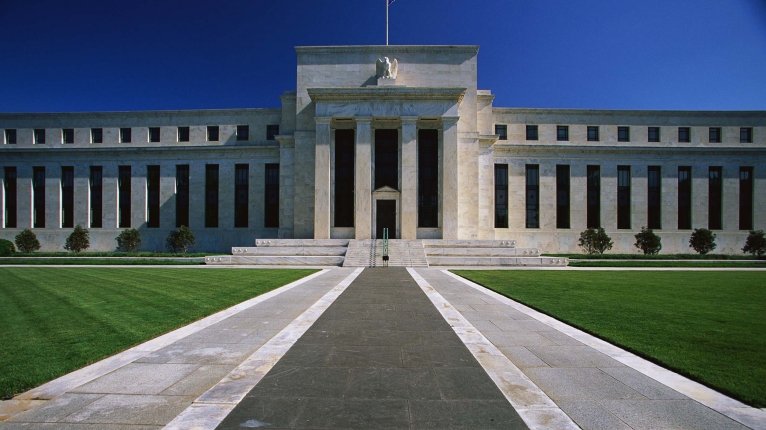Economic outlook December 2023 Fed meeting: Rates stay put
- The Federal Reserve (Fed) decided to hold its policy rate in 5.25%–5.5% range.
- The Fed’s statements indicate three quarter-point cuts next year.
- Inflation has eased but still remains elevated.
- Equities popped on the news as yields across the curve fell following the release.

In a widely expected move, the Federal Reserve (Fed) said it will keep the overnight federal funds rate steady in its range of 5.25% to 5.5% in its latest policy meeting.1 This marks the third consecutive meeting where the central bank has chosen to hold off on monetary policy changes. The Fed signaled it would cut rates three times in 2024 in projections released after officials’ two-day meeting.2
In its statement, the Fed indicated that after its long tightening campaign to battle decades-high inflation, U.S. economic growth has slowed and “inflation has eased over the past year but remains elevated.”
Sarah Stillpass, a Global Investment Strategist on J.P. Morgan’s Global Investment Strategy team, noted that the Fed’s decidedly dovish tone came as a surprise to markets.
“The Federal Reserve, as expected, decided to hold policy rates steady at its December Federal Open Market Committee (FOMC) meeting,” said Stillpass. “But, while the Fed’s move was largely expected, the dovish commentary was not." Stillpass added that the unexpected optimism was likely a result of "promising inflation and moderating jobs data.”
As a result, markets rose on the day as U.S. equities closed not far from all-time highs.
Fed officials’ median Summary of Economic Projections shows the federal funds rate falling three-quarters of a percentage point to 4.6% by the end of 2024 and to 3.6% – indicating four quarter-point cuts – by 2025. No Fed officials see rates higher by the end of next year.
After raising the policy rate by 5.25 percentage points since March 2022 – in one of the Fed’s fastest and biggest rate hike campaigns – it has now held the rate steady since July as inflation inches closer to its 2% target rate, from a high of over 9% in 2022.
“FOMC projections now call for 75 basis points of rate cuts in 2024 as the Fed sent a clear signal that the hiking cycle is likely over and a soft landing could be on the horizon,” said Stillpass on rate cuts. “The Fed also adjusted their 2024 inflation outlook from 2.6% to 2.4%.”
In his press conference after the announcement, Fed Chair Jerome Powell said that while “we believe that our policy rate is likely at or near its peak for this tightening cycle, the economy has surprised forecasters in many ways since the pandemic and ongoing progress,” and Federal Open Market Committee members did not want to take further hikes “off the table.”
The statement said the committee would take into consideration multiple factors – including the lagging effects of monetary policy on the economy – for “any additional policy firming that may be appropriate” to rein in inflation.
Powell addressed the word “any,” which was not in previous policy statements, hinting at the possibility that the Fed’s rate hikes are done: "We added 'any' as an acknowledgment that we are likely at or near the peak rate for this cycle. Participants didn't write down additional hikes that we believe are likely, so that's what we wrote down. But participants also didn't want to take the possibility of further hikes off the table, so that's really what we were thinking."
‘Inflation has eased’
Powell said the Fed is pleased with the progress on inflation, but “we need to see more.”
Consumer inflation dropped slightly in November to a 3.1% annual rate, and was up 0.1% from October. The Fed’s preferred inflation metric, core CPI, which strips out volatile food and energy prices, rose 0.3% in November, and 4% from the year-ago period. The core index rose by 3.7% in October from the year before. And no doubt, the Fed still sees work ahead in bringing its target inflation rate down to 2%.
Powell noted that prices of some consumer items are coming down, but price levels in aggregate are not. Real wages are rising more than inflation – a mitigating factor – but he acknowledged that people are still affected by inflation.
The FOMC forecasts economic growth for 2023 to hit 2.6%, slightly higher than its September projections that real gross domestic product would grow 2.1% this year. Members estimate real GDP growth will hit 1.4% by the end of 2024, down slightly from previous forecasts of 1.5%, before rebounding to 1.8% in 2025 and 1.9% in 2026. That suggests they don't expect the U.S. economy to enter a recession for at least two years.
Stillpass commented on GDP growth estimates and how they may impact the Fed’s decision making.
“Growth expectations were adjusted to 1.4% in 2024, down from 2.6% in 2023 – underscoring that the Fed expects a slowdown,” said Stillpass. “This is in line with our view: while we do not expect a recession, we do expect growth to slow as a result of restrictive rates. This is a necessary step on the path toward a soft landing.”
The U.S. economy grew faster than anticipated in the third quarter, with GDP rising at a revised 5.2% annualized pace in the third quarter, the fastest in nearly two years.
“There’s little basis for thinking the economy is in a recession now,” Powell said in his press conference, though “there’s always a real possibility there will be recession in the next year.”
Powell added that there is a strong chance the economy could cool in a way that allowed inflation to abate without the kind of large job losses typically associated with high inflation and tightening cycles. “So far, that's what we're seeing. That's what many forecasters on and off the committee are seeing,” he said. But “it’s too early to declare victory.”
Bottom line
The Fed’s long-awaited shift from restrictive to normal monetary policy following its unprecedented rate-hiking action seems to be in view, demonstrating a real decline in inflation and loosening of the labor market. The Fed’s challenge now is striking a delicate balance: If it eases too soon, it risks inflation staying above the 2% target, and if it moves too slowly to cut rates, it risks the economy succumbing to the burden of higher interest rates and potentially significant job losses.
“The question that remains following Wednesday’s meeting is: Just how long does the Fed intend to keep rates at today’s restrictive policy range of 5.25%–5.5%?” said Stillpass. “We think that cuts will occur in the second half of 2024 and interest rates will fall throughout the year.”
Invest your way
Not working with us yet? Find a J.P. Morgan Advisor or explore ways to invest online.
The Know Editors
J.P. Morgan Wealth Management
J.P. Morgan Wealth Management
At J.P. Morgan Wealth Management, we have a diverse team of editors and writers from different backgrounds, age groups and investing expertise. When looking across our broad span of topics and articles, it’s often easy to pinpoint one si ...More
Footnotes
-
1
FOMC statement, Dec. 13, 2023.
-
2
Federal Reserve Board and Federal Open Market Committee, Summary of Economic Projections, December 12-13 FOMC meeting



